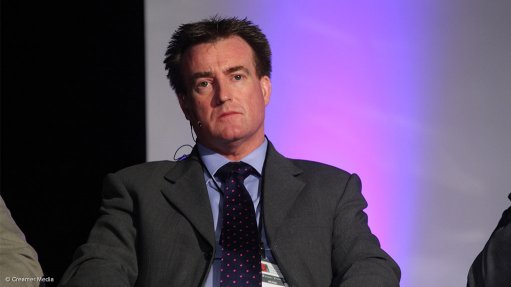
Karpowership sales director Patrick O’Driscoll
Photo by: Duane Daws
Turkish floating power plant group Karpowership says it has identified several potential sites along South Africa’s coastline where it could berth or moor vessels with generating capacities of up to 500 MW, indicating that the sites are generally located near load centres in the Western and Eastern Cape provinces.
Sales director Patrick O’Driscoll, who is marketing the concept to the South African government and Eskom as a way of addressing the country’s near-term supply shortfalls, acknowledges that the sites have only been interrogated as part of desktop studies.
However, he tells Engineering News Online that the company does not view siting or grid connectivity as major obstacles, with the ships equipped with onboard substations able to inject electricity at voltages specified by the offtaker.
Part of the larger family-owned Karadeniz Holdings group, the company claims to be in a position to introduce around 500 MW of capacity into South Africa by year-end and as much as 2 000 MW within 18 months.
It builds, owns and operates three classes of vessel, ranging in size from 100 MW to 500 MW, and has about 1 200 MW currently in operation globally.
Karpowership recently secured a ten-year power purchase agreement with Ghana for 450 MW, with the initial generation scheduled to begin by year-end.
O’Driscoll says the powerships are able to operate on both natural gas and heavy fuel oil (HFO), with the latter primary-energy source likely to be used in South Africa, owing to inadequate immediate supplies of natural gas.
Karpowership argues that its HFO is easily accessible and trades at a material discount to diesel, which would make the electricity produced by the floating power stations cheaper than output currently produced from the open-cycle gas-turbines (OCGTs) in the Western Cape.
“There are significant savings when compared with the OCGTs,” O’Driscoll avers, adding that the plants can be used as either peaking, mid-merit or baseload solutions, depending on the needs of the offtaker.
But a major value proposition for South Africa is the prospect of being able to introduce capacity in a short timeframe, and well within the 24- to 36-month horizon for demand exceeding supply outlined by President Jacob Zuma in his recent response to the Presidency Budget Vote.
O’Driscoll tells Engineering News Online that he has received a positive reaction from both the private and public sectors in South Africa, but given the size of the offering, the offtaker would probably need to be Eskom, which would still need to conduct its own due diligence.
Acting CEO Brian Molefe has already referred to powerships as a possible remedy to reducing the threat of daily load-shedding. However, South Africa was also pursuing a number of other short-term solutions, from cogeneration to demand-response schemes. In addition, any public procurement of power would also likely need to be subjected to a competitive-bidding process, in line with the country’s legislative and regulatory requirements.
Nevertheless, O’Driscoll remains optimistic, arguing that, over a five-year period, the powership solution had the ability to delivery a R43-billion saving when compared with the cost of operating the OCGTs.